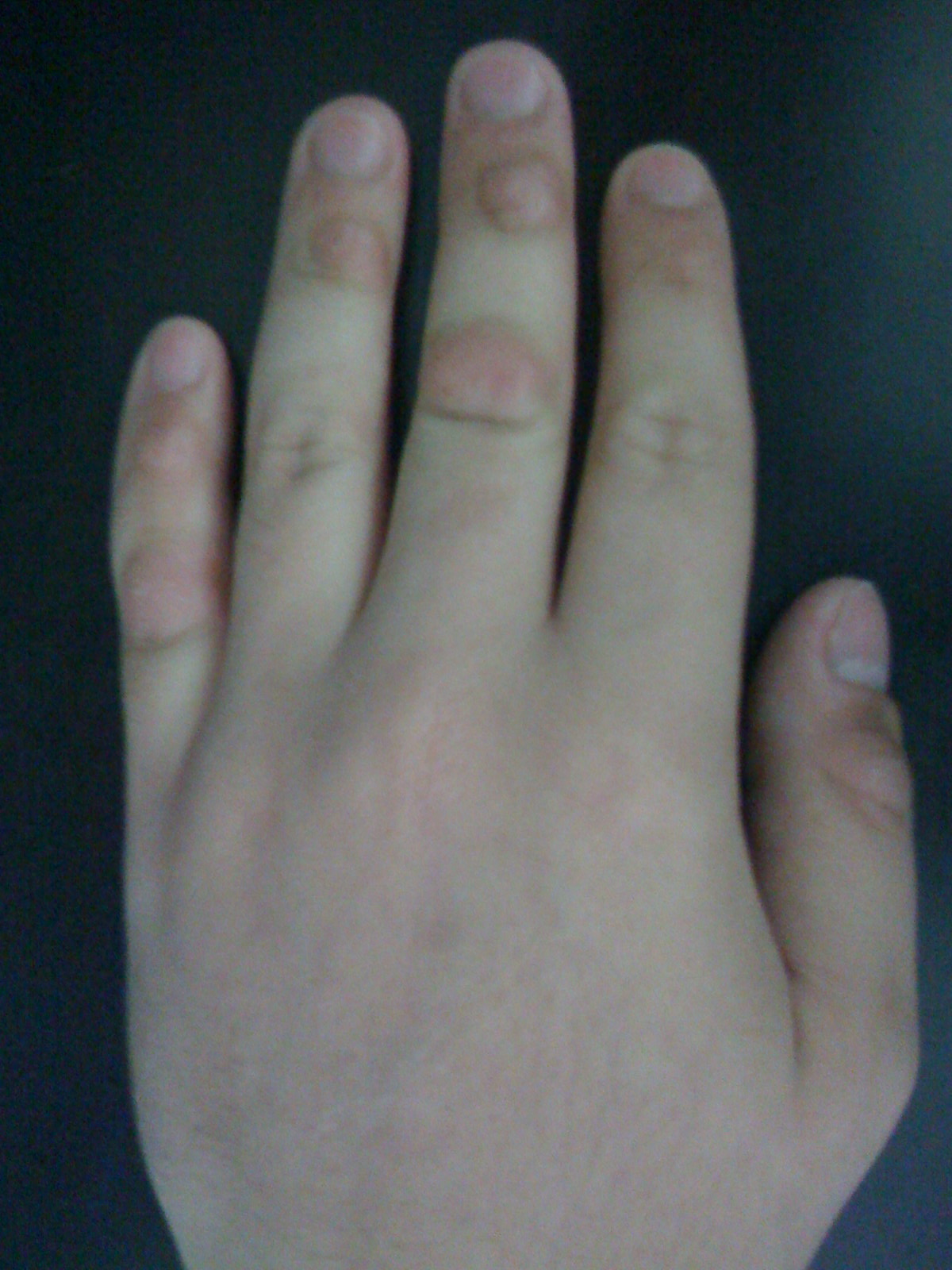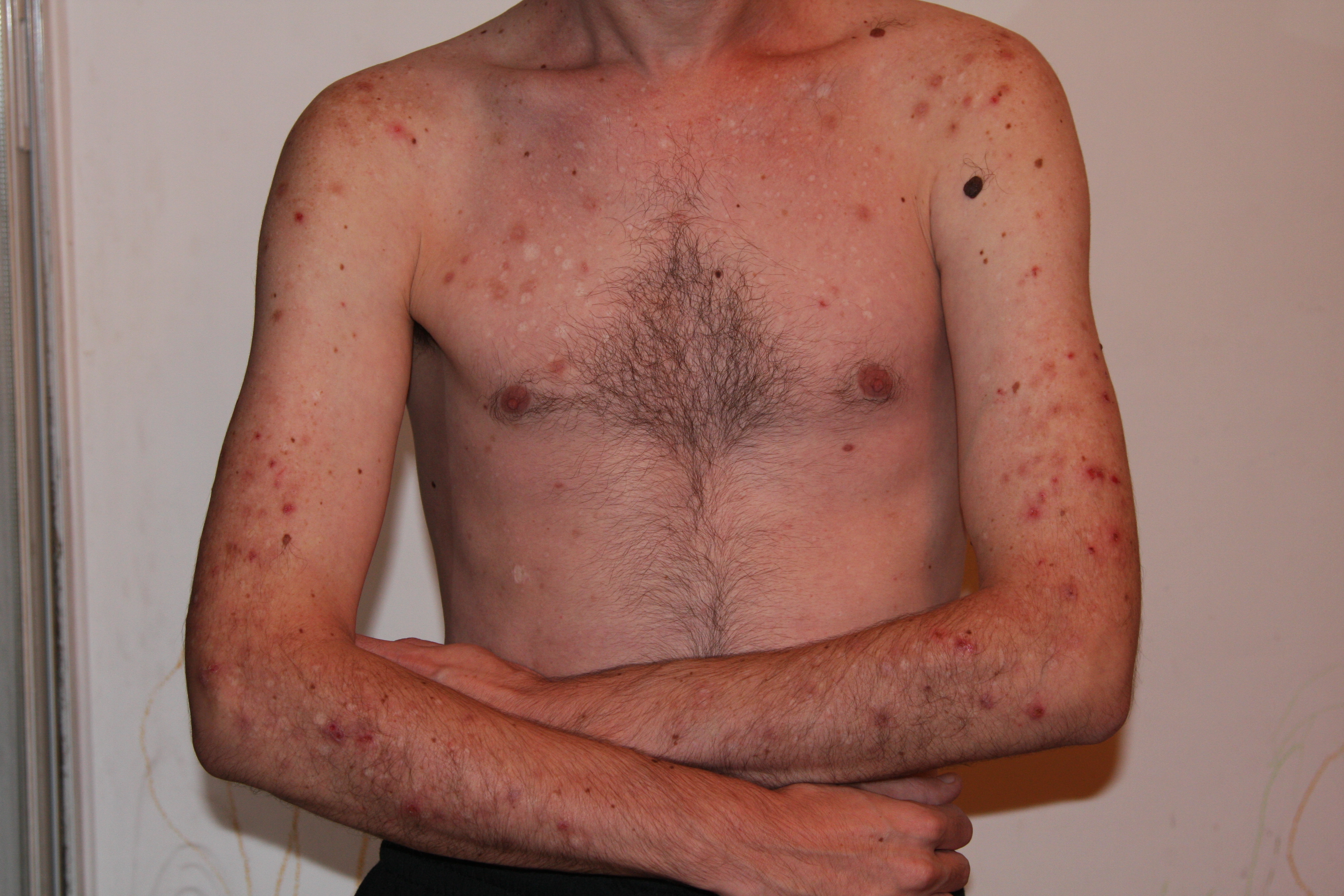Excoriation disorder: Difference between revisions
Sergekorjian (talk | contribs) (/* DSM-V Diagnostic Criteria for Excoriation (Skin-Picking) Disorder {{cite book | title = Diagnostic and statistical manual of mental disorders : DSM-5 | publisher = American Psychiatric Association | location = Washington, D.C | year = 2013 | isbn = ...) |
No edit summary |
||
| Line 1: | Line 1: | ||
__NOTOC__ | __NOTOC__ | ||
{{SI}} | {{SI}} | ||
{{CMG}} {{AE}} {{KS}} | {{CMG}} {{AE}} {{KS}} {{Y.A}} | ||
{{SK}} Compulsive skin picking; CSP; dermatillomania; neurotic excoriation; psychogenic excoriation | {{SK}} Compulsive skin picking; CSP; dermatillomania; neurotic excoriation; psychogenic excoriation | ||
| Line 10: | Line 10: | ||
Sufferers of dermatillomania find skin picking to be stress relieving or gratifying, though it can still be as physically painful as it would be for a non-skin picker. | Sufferers of dermatillomania find skin picking to be stress relieving or gratifying, though it can still be as physically painful as it would be for a non-skin picker. | ||
== | ==Historical Perspective== | ||
Episodes of skin picking are often preceded or accompanied by tension, anxiety, stress, or paranoia. During these moments, there is commonly a compulsive urge to pick, bite, or scratch at a surface or region of the body, often at the location of a perceived skin defect. Sufferers may experience relief from upsetting emotions by engaging in skin picking. | Episodes of skin picking are often preceded or accompanied by tension, anxiety, stress, or paranoia. During these moments, there is commonly a compulsive urge to pick, bite, or scratch at a surface or region of the body, often at the location of a perceived skin defect. Sufferers may experience relief from upsetting emotions by engaging in skin picking. | ||
| Line 22: | Line 22: | ||
Many dermatillomania sufferers find that the disorder interferes with daily life. Plagued by shame, embarrassment, and humiliation, they may take measures to hide their disorder by not leaving the home, wearing long sleeves and pants in summer, or covering visible damage to skin with cosmetics and/or bandages. The disorder is typically found among females more than males.{ | Many dermatillomania sufferers find that the disorder interferes with daily life. Plagued by shame, embarrassment, and humiliation, they may take measures to hide their disorder by not leaving the home, wearing long sleeves and pants in summer, or covering visible damage to skin with cosmetics and/or bandages. The disorder is typically found among females more than males.{ | ||
== | ==Classification== | ||
The inability to control the urge to pick is similar to trichotillomania.<ref>http://www3.interscience.wiley.com/cgi-bin/abstract/90513484/ABSTRACT?CRETRY=1&SRETRY=0</ref> Recent research suggests that, like trichotillomania, dermatillomania may be an [[impulse control disorder]]. This is part of the [[Obsessive-Compulsive Spectrum Disorder|obsessive compulsive disorder spectrum]].<ref>[http://www.brainexplorer.org/ocd/OCD_Related_%20Spectrum_%20Disorders.shtml Brain Explorer - Focus on Brain Disorders - OCD - Related Spectrum Disorders<!-- Bot generated title -->]</ref> | The inability to control the urge to pick is similar to trichotillomania.<ref>http://www3.interscience.wiley.com/cgi-bin/abstract/90513484/ABSTRACT?CRETRY=1&SRETRY=0</ref> Recent research suggests that, like trichotillomania, dermatillomania may be an [[impulse control disorder]]. This is part of the [[Obsessive-Compulsive Spectrum Disorder|obsessive compulsive disorder spectrum]].<ref>[http://www.brainexplorer.org/ocd/OCD_Related_%20Spectrum_%20Disorders.shtml Brain Explorer - Focus on Brain Disorders - OCD - Related Spectrum Disorders<!-- Bot generated title -->]</ref> | ||
In some animal models, it has been shown that animals that who excessively pull their hairs have more endorphin receptors in their brain than animals who do not. Endorphin receptors enable endorphins to have an effect on the brain. If this is true for humans, people who are particularly compulsive about their repetitive habits may have more endorphin receptors in their brain as well. This may explain why sufferers get more enjoyment out of picking their scabs than others. | In some animal models, it has been shown that animals that who excessively pull their hairs have more endorphin receptors in their brain than animals who do not. Endorphin receptors enable endorphins to have an effect on the brain. If this is true for humans, people who are particularly compulsive about their repetitive habits may have more endorphin receptors in their brain as well. This may explain why sufferers get more enjoyment out of picking their scabs than others. | ||
==Pathophysiology== | |||
==Differential Diagnosis== | ==Differential Diagnosis== | ||
| Line 53: | Line 55: | ||
*[[Obsessive-compulsive disorder]]([[OCD]])<ref name=DSMV>{{cite book | title = Diagnostic and statistical manual of mental disorders : DSM-5 | publisher = American Psychiatric Association | location = Washington, D.C | year = 2013 | isbn = 0890425558 }}</ref> | *[[Obsessive-compulsive disorder]]([[OCD]])<ref name=DSMV>{{cite book | title = Diagnostic and statistical manual of mental disorders : DSM-5 | publisher = American Psychiatric Association | location = Washington, D.C | year = 2013 | isbn = 0890425558 }}</ref> | ||
==Natural History, complications, and prognosis== | |||
==Diagnostic Criteria== | ==Diagnostic Criteria== | ||
===DSM-V Diagnostic Criteria for Excoriation (Skin-Picking) Disorder <ref name=DSMV>{{cite book | title = Diagnostic and statistical manual of mental disorders : DSM-5 | publisher = American Psychiatric Association | location = Washington, D.C | year = 2013 | isbn = 0890425558 }}</ref>=== | ===DSM-V Diagnostic Criteria for Excoriation (Skin-Picking) Disorder <ref name=DSMV>{{cite book | title = Diagnostic and statistical manual of mental disorders : DSM-5 | publisher = American Psychiatric Association | location = Washington, D.C | year = 2013 | isbn = 0890425558 }}</ref>=== | ||
Revision as of 17:10, 14 January 2019
Editor-In-Chief: C. Michael Gibson, M.S., M.D. [1] Associate Editor(s)-in-Chief: Kiran Singh, M.D. [2] Yashasvi Aryaputra[3]
Synonyms and keywords: Compulsive skin picking; CSP; dermatillomania; neurotic excoriation; psychogenic excoriation
Overview
Excoriation disorder (also known as dermatillomania, compulsive skin picking, neurotic excoriation, psychogenic excoriation, or CSP) is an impulse control disorder and form of self-injury characterized by the repeated urge to pick at one's own skin, often to the extent that damage is caused. Excoriation disorder may be related to body dysmorphic disorder (BDD).

Sufferers of dermatillomania find skin picking to be stress relieving or gratifying, though it can still be as physically painful as it would be for a non-skin picker.
Historical Perspective
Episodes of skin picking are often preceded or accompanied by tension, anxiety, stress, or paranoia. During these moments, there is commonly a compulsive urge to pick, bite, or scratch at a surface or region of the body, often at the location of a perceived skin defect. Sufferers may experience relief from upsetting emotions by engaging in skin picking.

The regions most commonly affected by this are the face, back, scalp, stomach, chest, and extremities such as the hands, feet, and arms. Physical indicators of dermatillomania most commonly expressed in these areas are swelling, scarring, and callusing due to damage to the affected region's epidermis.
Aware of the damage they are inflicting, many sufferers feel and recognize a need to stop the behavior but are physically and mentally unable to do so without aid. Additionally, the behavior's addict-like characteristics are very similar to the expression of trichotillomania, or the compulsive pulling of hair from the body.
Many dermatillomania sufferers find that the disorder interferes with daily life. Plagued by shame, embarrassment, and humiliation, they may take measures to hide their disorder by not leaving the home, wearing long sleeves and pants in summer, or covering visible damage to skin with cosmetics and/or bandages. The disorder is typically found among females more than males.{
Classification
The inability to control the urge to pick is similar to trichotillomania.[1] Recent research suggests that, like trichotillomania, dermatillomania may be an impulse control disorder. This is part of the obsessive compulsive disorder spectrum.[2]
In some animal models, it has been shown that animals that who excessively pull their hairs have more endorphin receptors in their brain than animals who do not. Endorphin receptors enable endorphins to have an effect on the brain. If this is true for humans, people who are particularly compulsive about their repetitive habits may have more endorphin receptors in their brain as well. This may explain why sufferers get more enjoyment out of picking their scabs than others.
Pathophysiology
Differential Diagnosis
- Neurodevelopmental disorders
- Other obsessive-compulsive and related disorders
- Other disorders
- Other medical conditions
- Delusion
- Tactile hallucination
- Somatic symptom and related disorders
- Substance/medication-induced disorders
Epidemiology and Demographics
Prevalence
The prevalence of excoriation (skin-picking) disorder is 1,400 per 100,000 (1.4%) of the overall population.[3]
Risk Factors
- Genetic predisposition
- Obsessive-compulsive disorder(OCD)[3]
Natural History, complications, and prognosis
Diagnostic Criteria
DSM-V Diagnostic Criteria for Excoriation (Skin-Picking) Disorder [3]
| “ |
AND
AND
AND
AND
|
” |
Treatment
Few mental health practitioners have studied the disease, as many of these cases go unreported, but some individuals have found relief through cognitive-behavioral therapy. Hypnosis, self-hypnosis and meditation have also been useful for some patients. They are also sometimes prescribed medications, such as those prescribed for obsessive compulsive disorder. For example, artificial fingernails (acrylic or gel) have been found to be useful to some in stopping the picking behavior.
References
- ↑ http://www3.interscience.wiley.com/cgi-bin/abstract/90513484/ABSTRACT?CRETRY=1&SRETRY=0
- ↑ Brain Explorer - Focus on Brain Disorders - OCD - Related Spectrum Disorders
- ↑ 3.0 3.1 3.2 3.3 Diagnostic and statistical manual of mental disorders : DSM-5. Washington, D.C: American Psychiatric Association. 2013. ISBN 0890425558.